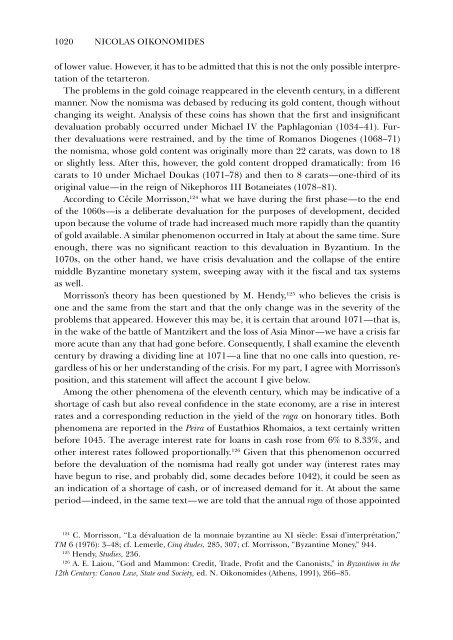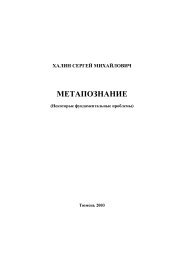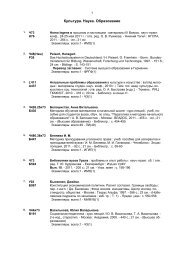The Economic History of Byzantium - Dumbarton Oaks
The Economic History of Byzantium - Dumbarton Oaks
The Economic History of Byzantium - Dumbarton Oaks
Create successful ePaper yourself
Turn your PDF publications into a flip-book with our unique Google optimized e-Paper software.
1020 NICOLAS OIKONOMIDES<br />
<strong>of</strong> lower value. However, it has to be admitted that this is not the only possible interpretation<br />
<strong>of</strong> the tetarteron.<br />
<strong>The</strong> problems in the gold coinage reappeared in the eleventh century, in a different<br />
manner. Now the nomisma was debased by reducing its gold content, though without<br />
changing its weight. Analysis <strong>of</strong> these coins has shown that the first and insignificant<br />
devaluation probably occurred under Michael IV the Paphlagonian (1034–41). Further<br />
devaluations were restrained, and by the time <strong>of</strong> Romanos Diogenes (1068–71)<br />
the nomisma, whose gold content was originally more than 22 carats, was down to 18<br />
or slightly less. After this, however, the gold content dropped dramatically: from 16<br />
carats to 10 under Michael Doukas (1071–78) and then to 8 carats—one-third <strong>of</strong> its<br />
original value—in the reign <strong>of</strong> Nikephoros III Botaneiates (1078–81).<br />
According to Cécile Morrisson, 124 what we have during the first phase—to the end<br />
<strong>of</strong> the 1060s—is a deliberate devaluation for the purposes <strong>of</strong> development, decided<br />
upon because the volume <strong>of</strong> trade had increased much more rapidly than the quantity<br />
<strong>of</strong> gold available. A similar phenomenon occurred in Italy at about the same time. Sure<br />
enough, there was no significant reaction to this devaluation in <strong>Byzantium</strong>. In the<br />
1070s, on the other hand, we have crisis devaluation and the collapse <strong>of</strong> the entire<br />
middle Byzantine monetary system, sweeping away with it the fiscal and tax systems<br />
as well.<br />
Morrisson’s theory has been questioned by M. Hendy, 125 who believes the crisis is<br />
one and the same from the start and that the only change was in the severity <strong>of</strong> the<br />
problems that appeared. However this may be, it is certain that around 1071—that is,<br />
in the wake <strong>of</strong> the battle <strong>of</strong> Mantzikert and the loss <strong>of</strong> Asia Minor—we have a crisis far<br />
more acute than any that had gone before. Consequently, I shall examine the eleventh<br />
century by drawing a dividing line at 1071—a line that no one calls into question, regardless<br />
<strong>of</strong> his or her understanding <strong>of</strong> the crisis. For my part, I agree with Morrisson’s<br />
position, and this statement will affect the account I give below.<br />
Among the other phenomena <strong>of</strong> the eleventh century, which may be indicative <strong>of</strong> a<br />
shortage <strong>of</strong> cash but also reveal confidence in the state economy, are a rise in interest<br />
rates and a corresponding reduction in the yield <strong>of</strong> the roga on honorary titles. Both<br />
phenomena are reported in the Peira <strong>of</strong> Eustathios Rhomaios, a text certainly written<br />
before 1045. <strong>The</strong> average interest rate for loans in cash rose from 6% to 8.33%, and<br />
other interest rates followed proportionally. 126 Given that this phenomenon occurred<br />
before the devaluation <strong>of</strong> the nomisma had really got under way (interest rates may<br />
have begun to rise, and probably did, some decades before 1042), it could be seen as<br />
an indication <strong>of</strong> a shortage <strong>of</strong> cash, or <strong>of</strong> increased demand for it. At about the same<br />
period—indeed, in the same text—we are told that the annual roga <strong>of</strong> those appointed<br />
124 C. Morrisson, “La dévaluation de la monnaie byzantine au XI siècle: Essai d’interprétation,”<br />
TM 6 (1976): 3–48; cf. Lemerle, Cinq études, 285, 307; cf. Morrisson, “Byzantine Money,” 944.<br />
125 Hendy, Studies, 236.<br />
126 A. E. Laiou, “God and Mammon: Credit, Trade, Pr<strong>of</strong>it and the Canonists,” in <strong>Byzantium</strong> in the<br />
12th Century: Canon Law, State and Society, ed. N. Oikonomides (Athens, 1991), 266–85.








